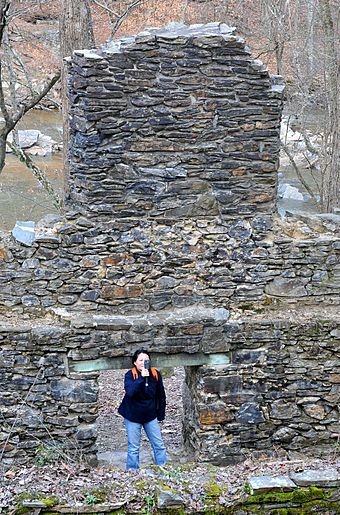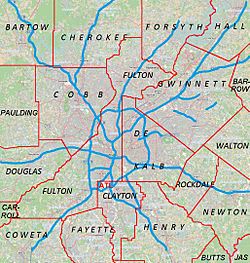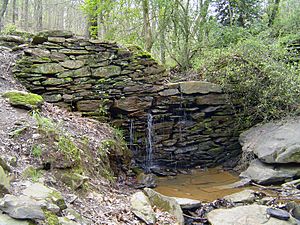Sope Creek Ruins facts for kids
Quick facts for kids |
|
|
Sope Creek Ruins
|
|

Sope Creek Ruins (2012)
|
|
| Nearest city | Marietta, Georgia |
|---|---|
| Area | 182 acres (74 ha) |
| NRHP reference No. | 73000619 |
| Added to NRHP | April 27, 1973 |
The Sope Creek Ruins are old industrial buildings located in Cobb County, Georgia. You can find them where Paper Mill Road meets Sope Creek. These ruins are what's left of a large group of factories. These factories used the power of the creek's water to run their machines. From the 1850s to the 1940s, different businesses operated here. They included a paper mill, a twine factory, a flour mill, and a hydroelectric power plant. All these businesses were spread out along about one mile of the creek.
The paper mill at Sope Creek was run by Marietta Paper Mills. It officially started on December 19, 1859. Andrew Schofield Edmondston and Saxon A. Anderson likely started it. The paper mill had many buildings. These included the main mill, an oil room, an office, and a special channel for water called a sluice. There was also a storeroom, a dam, a machine shop, and a pulp-grinding mill.
This historical site was added to the National Register of Historic Places on April 27, 1973. This list helps protect important places in the United States.
Contents
Paper Production During the Civil War
During the American Civil War, it was hard for the paper mill to keep working. In September 1863, Mr. A.S. Edmondston, who ran the paper mill, wrote a letter to the Daily Intelligencer newspaper. He explained that his mill was the newspaper's main paper supplier. However, they could not send much paper because of the war.
Edmondston wrote that his workers had joined the Home Guard. This group protected the area from attacks. Some workers were also called to guard stores and prepare defenses for the city. He said that at the start of the war, he encouraged two workers to join the Confederate army. This left them with very few workers. Later, they lost more workers. Because of this, one machine could only run when workers put in 18-hour days.
Edmondston also complained that the Confederate government needed paper. But they did not see paper workers as important for the war. He said it was hard to find paper makers in the South. He felt they should get the same special treatment as shoemakers, who were often excused from fighting.
The paper supply became even worse on July 5, 1864. Union soldiers, led by General Gerrard, burned the Marietta Paper Mill. They also burned Denmead's Flour Mill. The paper mill was rebuilt in 1865. But it burned down again in 1870 and was rebuilt in 1871. The mill struggled to stay open after this second rebuilding.
In 1873, the mills were sold. They were then reorganized as the Marietta Paper Manufacturing Company. In 1888, a wood pulp mill was added. A twine factory was added in 1889. Finally, in 1902, the mill stopped making products at this location.
Newspaper Stories About the Ruins
In May 1932, the Atlanta Constitution newspaper printed a picture of the paper mill ruins. The picture's caption said that the "GREAT WALLS BUILT BY SLAVE LABOR" before the Civil War. This is the only mention of slavery related to the Sope Creek Industrial Area. The caption also suggested the paper mill never recovered from being burned. But it actually was rebuilt and operated for many more years.
In 1933, the Atlanta Journal newspaper published an article. It looked back at the Marietta Paper Mills. H.H. Cabaniss, a senior staff member at the Journal, added a note. He remembered that the Marietta Paper Mills, owned by Saxon A. Anderson, supplied paper to many Atlanta newspapers. In 1867, Cabaniss was a business manager for the Atlanta New Era newspaper. He bought his paper in large rolls from the Marietta Paper Mills.
Flour Mill and Power Plant
Besides the paper mill, there was also Denmead's Flour Mill. Edward Denmead built this flour mill in 1855. It was on the west bank of the creek, about 200 yards from where Paper Mill Road crosses Sope Creek. Denmead ran this mill and shared a road with the Marietta Paper Mills. The flour mill was burned at the same time as the paper mill. But it was never rebuilt.
In 1922, a hydroelectric dam and a power plant were built. They were on the west side of the creek, about 900 yards upstream from Paper Mill Road. By 1973, this dam was no longer working.
When a report was made in 1973, it described every remaining structure in great detail. It was so accurate that someone could find and identify all the remaining buildings. The largest remaining building was the mill building. It was about a quarter-mile downstream from Paper Mill Road on the east bank. It had five rooms and was about 300 feet long. The oil room and office were nearby. The pulp-grinding mill was just south of Paper Mill Road. It was two stories high and about 100 feet long. Denmead's flour mill was also described. Even the foundations of an old bridge near the dam were identified.
The Myth of the Confederate Mint
Some people believe that the Confederate States of America printed money at Sope Creek. However, there is no evidence of a printing press or a mint at the mill. This idea likely came from a single newspaper article.
In 1968, the New York Times printed an article about the Atlanta Golf Classic. The golf course was near Sope Creek. The article mentioned a golf hole where "off to the right of the green is the site of a former Confederate mint." The only person quoted in the article, besides the golfers, was the tournament director.
Research shows there was no mint at the mill on Sope Creek. The Marietta Paper Mill was one of the first mills in Georgia to use wood. It started in 1864, shortly after the original mill was burned. The mill made newsprint paper by grinding pine trees and mixing them with imported pulp. One of the main products they made was paper for Confederate money. The story of a "mint" probably grew from the fact that the mill made and shipped the paper that Confederate money was printed on. The mill did not print money itself.
- Video of the Marietta Paper Mill Ruins: [1]





